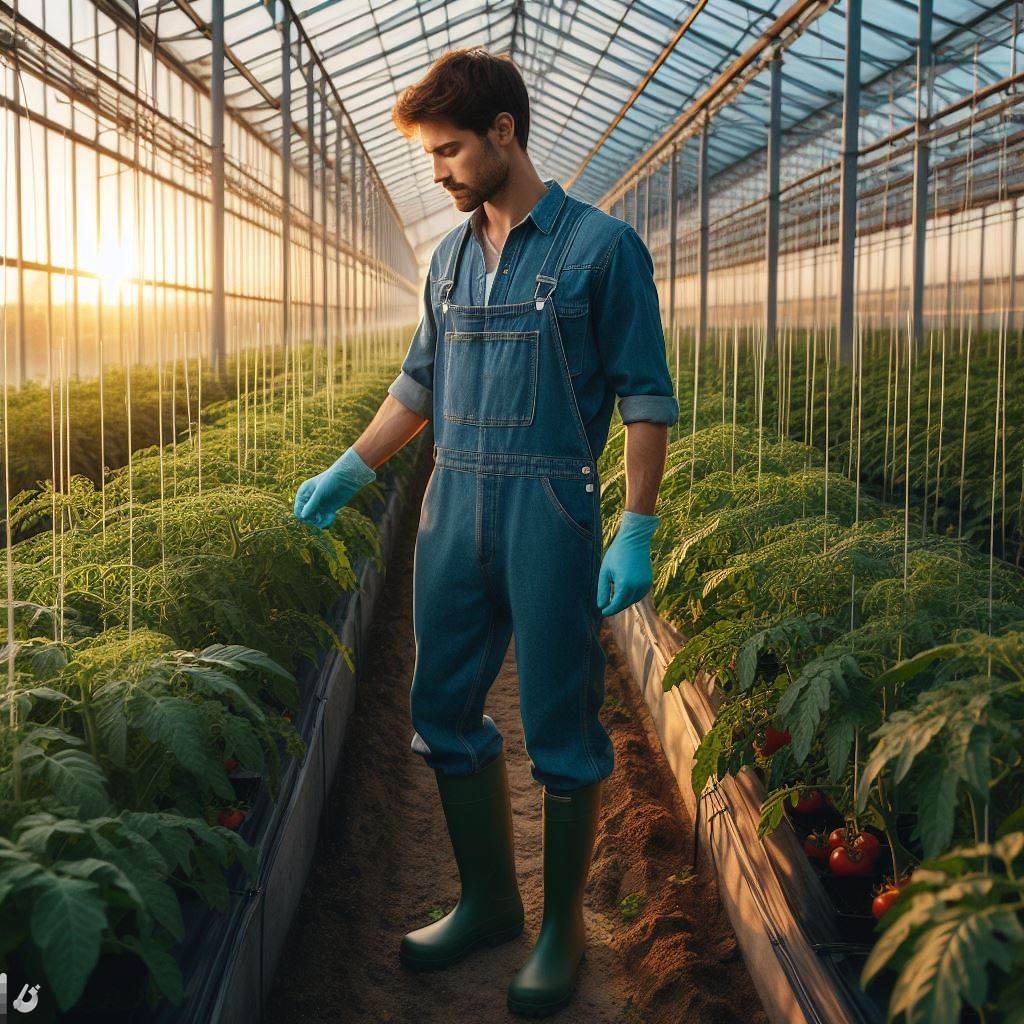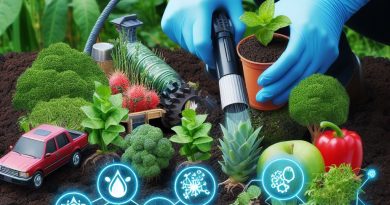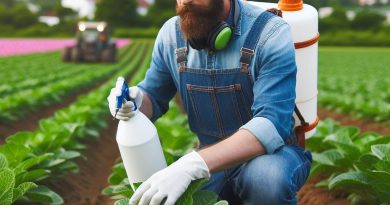Greenhouse Farming in a Changing Climate
Last Updated on March 5, 2024
Introduction
Greenhouse farming has gained immense importance in recent years due to its ability to provide a controlled environment for cultivating crops.
This method involves the use of structures made of transparent materials such as glass or plastic to capture sunlight and create a warm, stable environment.
The impact of climate change on agriculture has been a growing concern globally.
Rising temperatures, erratic rainfall patterns, and extreme weather events pose challenges to traditional farming practices.
Crops are becoming more susceptible to diseases, pests, and droughts, leading to decreased yields and food shortages.
Greenhouse farming offers a potential solution to mitigate the effects of climate change on agriculture.
By creating a controlled environment, farmers can regulate temperature, humidity, and light to optimize crop growth.
This method allows for year-round production irrespective of external weather conditions, minimizing the risk of crop failure.
Additionally, it reduces the dependency on chemical inputs, water, and land, making it an environmentally sustainable choice.
Moreover, greenhouse farming offers the opportunity to grow non-native or out-of-season crops.
This enables farmers to diversify their produce and meet the increasing demand for exotic fruits, vegetables, and herbs.
It also reduces the need for long-distance transportation, thus lowering carbon emissions associated with food supply chains.
In fact, greenhouse farming emerges as a viable alternative to traditional agriculture in the face of climate change.
Its ability to provide a controlled environment for crop production contributes to food security, sustainability, and resilience in a changing climate.
By embracing this innovative farming technique, we can ensure a more secure and resilient future for our agricultural systems.
Understanding Greenhouse Farming
A. Definition and concept of greenhouse farming
- Greenhouse farming refers to the practice of cultivating plants inside specially designed structures.
- These structures, made of glass or plastic, allow for the control of temperature, humidity, and other environmental factors.
- The concept is to create a microclimate that enhances plant growth and protects crops from adverse weather conditions.
B. Types of greenhouse structures
- There are several types of greenhouse structures, including hoop houses, venlo, and quonset.
- Hoop houses are low-cost structures made of arched hoops covered with plastic.
- Venlo greenhouses have a rectangular shape and are made of glass or polycarbonate sheets.
- Quonset greenhouses have a semicircular shape and are covered with plastic or polycarbonate materials.
C. Key components and technologies used in greenhouse farming
- Greenhouses comprise various components and utilize advanced technologies to optimize plant growth.
- Some key components include ventilation systems, heating systems, irrigation systems, and shading systems.
- Technologies like automated climate control, hydroponics, and artificial lighting are commonly used.
- These technologies help maintain optimal growing conditions and improve productivity and yield.
D. Advantages and challenges of greenhouse farming
- Greenhouse farming offers several advantages over traditional open-field cultivation.
- It provides year-round crop production, allowing farmers to supply fresh produce consistently.
- Greenhouses also offer protection against pests, diseases, and extreme weather events.
- However, greenhouse farming faces challenges such as high initial investment costs and complex management.
- Energy consumption and environmental impact are also important considerations in greenhouse farming.
- Efforts are being made to improve energy efficiency and reduce the use of chemicals in greenhouse farming.
- Overall, greenhouse farming presents a promising solution to ensure sustainable food production in a changing climate.
Read: Managing Pests in Organic Vegetable Farms
Impact of Climate Change on Greenhouse Farming
As climate change continues to transform our planet, one area that is significantly affected is greenhouse farming.
Greenhouses are designed to control the environment in which crops grow, providing favorable conditions for their development.
However, with the increasing temperatures, changing precipitation patterns, and extreme weather events caused by climate change, greenhouse farming faces numerous challenges.
A. Increasing temperatures
One of the most significant impacts of climate change on greenhouse farming is the increasing temperatures.
Rising global temperatures can have adverse effects on plant growth and development.
Higher temperatures can accelerate the transpiration process in plants, leading to increased water loss.
This can result in dehydration and heat stress, stunting the growth of crops and reducing their overall productivity.
B. Changing precipitation patterns
Climate change also causes shifts in precipitation patterns, affecting water availability for greenhouse farming.
Changes in rainfall patterns can range from droughts to heavy downpours, both of which pose unique challenges for managing water in greenhouses.
Water scarcity due to droughts can hinder plant growth, while excessive rainfall can lead to flooding and waterlogging, affecting root health and nutrient absorption of crops.
Proper water management becomes crucial in greenhouse farming to mitigate the impacts of changing precipitation patterns.
Implementing efficient irrigation systems, such as drip irrigation or hydroponics, can help conserve water and ensure its optimal distribution to plants.
Additionally, capturing and storing rainwater can serve as a valuable resource during dry periods, reducing the dependence on external water sources.
C. Extreme weather events
Climate change is also responsible for an increase in extreme weather events, including heatwaves, cold spells, and storms.
These events pose a significant threat to greenhouse crops as they can damage or destroy plants, leading to substantial economic losses for farmers.
Extreme heat can cause sunburn, wilting, and reduced photosynthesis, affecting the overall health and productivity of plants.
On the other hand, cold temperatures and storms can result in frost damage, breakage of greenhouse structures, and waterlogging.
To protect crops from extreme weather events, greenhouse farmers employ various strategies.
Installing shading systems can provide relief from intense sunlight during heatwaves, reducing the risk of sun damage.
Likewise, using heating systems and insulation materials can help maintain optimal temperatures inside greenhouses during cold spells.
Strengthening greenhouse structures and implementing proper drainage systems can help minimize damage caused by storms and excessive rainfall.
In short, climate change significantly impacts greenhouse farming through increasing temperatures, changing precipitation patterns, and extreme weather events.
These factors affect plant growth, water management, and the overall resilience of greenhouse crops.
To adapt to these challenges, innovative strategies and technologies need to be implemented to optimize crop production while reducing the environmental impact.
Greenhouse farming must evolve to withstand the changing climate and continue to contribute to sustainable and reliable food production.
Read: Climate Impact on Potato Growth: What to Know

Adapting Greenhouse Farming to a Changing Climate
With the impacts of climate change becoming increasingly evident, greenhouse farming must adapt to ensure food security and sustainable practices.
As weather patterns become more unpredictable and extreme, greenhouse farmers need to implement various strategies to safeguard their crops and optimize yields.
Here are some essential steps to adapt greenhouse farming to a changing climate:
A. Implementing climate-controlled systems
- Heating and cooling strategies: Greenhouses can utilize heating and cooling techniques such as thermal insulation, ventilation systems, and shade structures to regulate temperatures.
These methods help maintain optimal conditions for plant growth, even when outdoor temperatures fluctuate. - Automation and monitoring technologies: Advanced technologies like sensors, automated climate controllers, and data analytics systems can be introduced in greenhouses.
These technologies enable real-time monitoring and precise control of environmental factors such as temperature, humidity, and carbon dioxide levels.
B. Enhancing water management
- Irrigation techniques and water-saving practices: Implementing efficient irrigation techniques like drip irrigation or hydroponics reduces water usage by delivering water directly to the plant roots.
Additionally, adopting water-saving practices like mulching and using moisture sensors prevents overwatering and water wastage. - Rainwater harvesting and storage: Utilizing rainwater collection systems and storage tanks can help greenhouse farmers meet their irrigation needs without relying solely on freshwater sources.
By harvesting rainwater, farmers can conserve water resources and minimize the strain on local water supplies.
C. Crop selection and diversification
- Choosing resilient plant varieties: It is crucial to select plant varieties that demonstrate resilience to changing climatic conditions.
Farmers can opt for heat-tolerant, drought-resistant, or disease-resistant crop varieties to enhance their chances of successful harvests, even in unfavorable weather conditions. - Crop rotation and intercropping: Rotating crops and intercropping can help mitigate the risks associated with climate change.
Alternating crops between different seasons and planting diverse species together can improve soil fertility, control pests and diseases, and reduce vulnerability to extreme climate events.
As the climate continues to change, greenhouse farmers must embrace adaptive measures to secure their farming operations.
By implementing climate-controlled systems, improving water management practices, and diversifying crop selection, greenhouse farmers can ensure resilient production systems.
Furthermore, technological advancements and innovative farming practices will play a crucial role in achieving sustainable greenhouse farming in a rapidly changing climate.
Read: Organic Fertilizers: Boosting Soil Health
Innovations and Future Prospects
Greenhouse farming faces numerous challenges in a changing climate, but with continuous research and development efforts, innovative technologies, and collaboration within the industry, there are promising prospects for the future.
A. Research and development efforts in greenhouse farming
Research and development efforts play a crucial role in advancing greenhouse farming techniques.
Scientists and researchers are dedicatedly working towards improving crop quality, reducing pesticide usage, and optimizing resource efficiency.
They are also developing new crop varieties that are more resilient to the changing climate.
Advanced technologies like genetic engineering and biotechnology are being explored for enhanced yields.
Moreover, research is focused on understanding and addressing the impacts of climate change on greenhouse farming, including the development of mitigation strategies.
B. Emerging technologies for climate resilience
To ensure climate resilience, emerging technologies are being integrated into greenhouse farming practices.
These technologies include innovative climate control systems that can adapt to changing weather patterns.
Automated monitoring systems regulate temperature, humidity, and CO2 levels, creating ideal growth conditions for plants.
Smart irrigation systems optimize water usage and minimize wastage.
Solar panels and other renewable energy sources are being utilized to ensure sustainable energy generation.
Additionally, vertical farming techniques are being employed, maximizing space utilization and increasing production capacity.
C. Collaborations and knowledge sharing in the industry
Collaboration and knowledge sharing are vital for the growth of the greenhouse farming industry.
Stakeholders, including farmers, scientists, and government agencies, are coming together to share knowledge and best practices.
Research institutions are forming partnerships with greenhouse farmers to conduct field trials and implement innovative solutions on a larger scale.
International organizations are playing a crucial role in facilitating knowledge transfer and capacity building in the greenhouse farming sector.
Farmer networks and associations are organizing workshops and conferences to promote knowledge exchange and foster collaboration.
Open-source platforms and online forums provide a space for professionals to share their experiences and learn from each other.
In general, while greenhouse farming in a changing climate presents challenges, there is a bright future ahead with ongoing research and development efforts, emerging technologies for climate resilience, and collaborations within the industry.
By continuously striving for innovation and knowledge sharing, greenhouse farming can adapt to climate change and contribute to sustainable agriculture.
Read: Irrigation Methods for Rice: Maximizing Yield
Uncover the Details: Crop Rotation: Enhancing Soil Fertility
Find Out More: Managing Pests in Organic Farming
Conclusion
A. Recap of the importance of greenhouse farming
Greenhouse farming emerges as a crucial solution amid a changing climate.
- Climate Challenges: Greenhouses shield crops from extreme weather, securing yields in unpredictable conditions.
- Resource Efficiency: Controlled environments optimize water and nutrient use, reducing agricultural resource demands.
- Extended Growing Seasons: Greenhouses extend growing seasons, ensuring a more consistent and reliable food supply.
- Pest and Disease Control: Controlled environments minimize the impact of pests and diseases, promoting healthier crops.
B. Need for proactive measures to adapt to a changing climate
- Adaptation Strategies: Proactive measures involve integrating resilient crops and advanced technologies in greenhouse practices.
- Climate-Resilient Varieties: Selecting and cultivating climate-resilient crop varieties enhance greenhouse farming’s adaptability.
- Innovative Technologies: Implementing smart technologies like automated climate control ensures real-time adjustments for changing weather patterns.
- Energy-Efficient Practices: Greenhouses can adopt energy-efficient systems, reducing reliance on fossil fuels and minimizing environmental impact.
- Research and Development: Continuous research is essential for developing advanced greenhouse techniques adaptable to evolving climate scenarios.
C. Encouragement for further exploration and investment in greenhouse farming for a sustainable future
- Sustainability Impact: Greenhouse farming aligns with sustainability goals, promoting responsible agriculture for future generations.
- Investment Opportunities: Investing in greenhouse technologies presents opportunities for innovation and economic growth in agriculture.
- Education and Training: Supporting educational programs fosters skilled professionals in greenhouse management, ensuring sustainable practices.
- Community Engagement: Encouraging community involvement in greenhouse initiatives enhances awareness and promotes sustainable agricultural practices.
- Government Support: Policymakers should offer incentives and policies that support and incentivize greenhouse farming for a sustainable agricultural future.
In close, greenhouse farming is pivotal in mitigating the challenges posed by a changing climate.
Proactive measures, coupled with continuous exploration and investment, will drive sustainable practices.
It is a collective responsibility to embrace and enhance greenhouse farming for a resilient and sustainable agricultural future.


